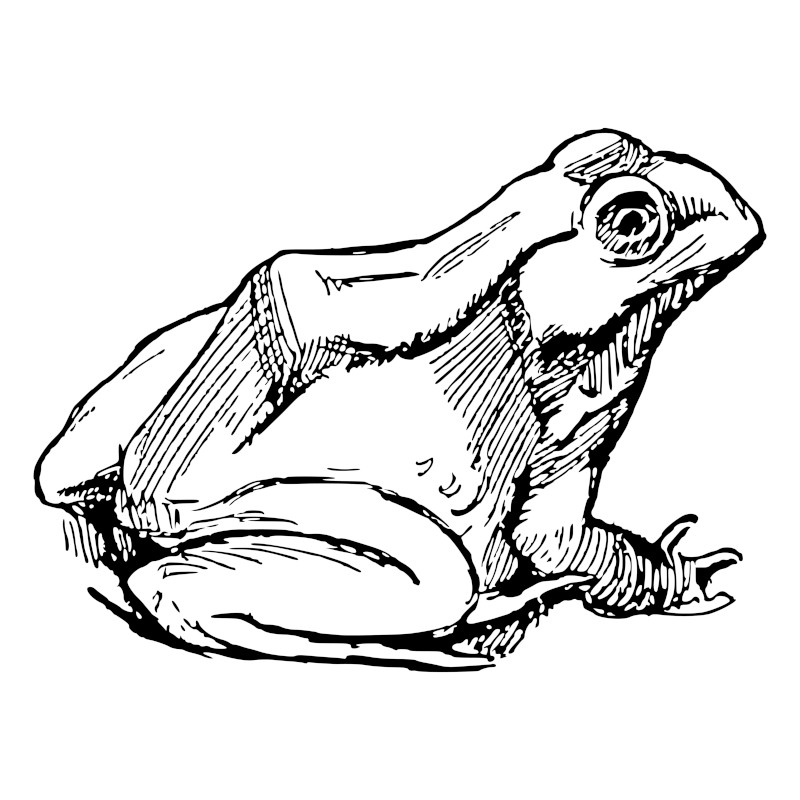Frogs have appeared in art in a vaeity of ways and in this article we will give tips and techniques on how to do a quick, easy drawing of a frog.
Introduction to Frog Drawings
Many artists have given character and personality to frogs within their work, and children have often found them a charming creature. From their unique sounds, to their long legs, as well as their strong tones of color, there is much to appreciate with the different species of frog. Their unique makeup does, however, bring particular challenges to artists, particularly for those looking to produce highly precise, scientific depictions of the different types of frog.
We have covered bird, fish and butterfly drawings in other articles, and hope that this series of content will give you inspiration to sketch a wide variety of creatures, with many artworks included for each one to give you a full summary of how they can be depicted within art. Many famous artists are also included within these lists, with a number of memorable paintings and drawings included.
List of Frog Drawings and Paintings
We have provided information alongside each artwork listed below, including details about the artist themselves, where their identity is known. Below this you will find further discussion on a number of topics related to frog drawings and paintings, including tips and techniques on how to easily draw a simple artwork of a frog or toad, as well as a guide to different tools and materials that you might use.
Frogs remains popular choices for artists, and can bring a sense of fun to your art. They can also be adapted in many different ways, simply by tweaking their facial features. Cartoons and children books regularly make use of frogs, and often they are given a cheeky, fun character which represents their diminutive size and energetic behavior.
Sitting Frog Line Illustration
Here we find a skillful illustration of a sitting frog. Shading is produced through a variation in intensity of line, some of which creates dark areas around the ridges of the frog's body. Its round eyes look out in curiosity, and the contours of its back are included by this anonymous artist. This illustration is probably from a vintage era, and could be traced as a means to understanding the basic structure and outlines of a frog, which could be beneficial for those learning how to easily and quickly draw a frog. There is sufficent detail here to pinpoint the particular species of frog found here, even without the use of color.
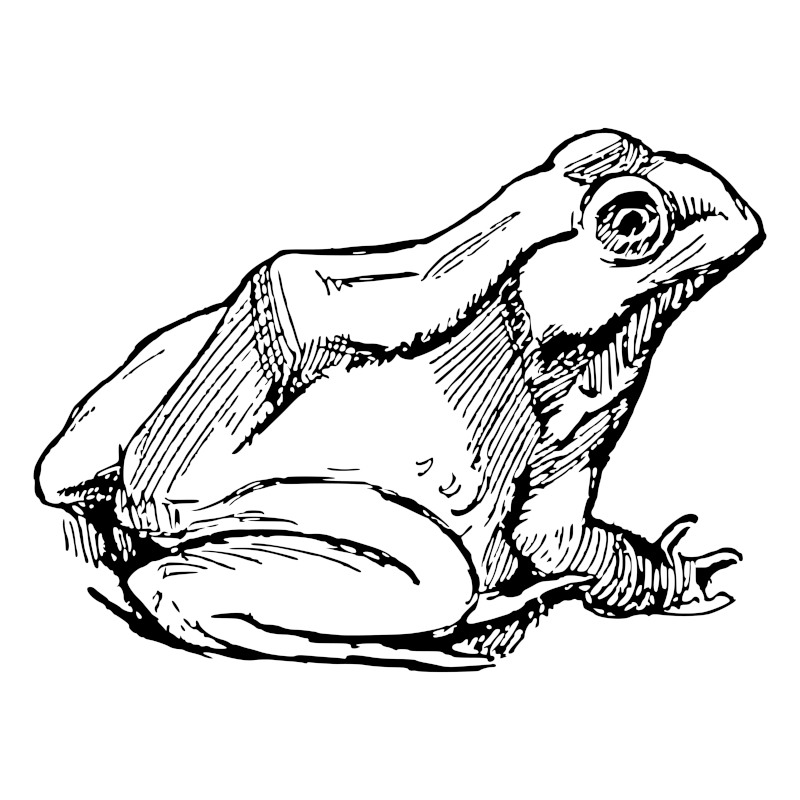 Sitting Frog Line Illustration (image courtesy of rawpixel, as copyright-free)
Sitting Frog Line Illustration (image courtesy of rawpixel, as copyright-free)
Bullfrog vintage illustration
This drawing has been identified as a bullfrog and is likely to be a vinstage age artwork. Notice the wide shape of this frog, along with the speckled contours on its side. The artist includes small touches of detail below the frog in order to place it within an outdoor setting, but the main focus is on the frog itself. This drawing is aiming for accuracy, as opposed to some of the fun, cartoon-like depictions which came around in the 20th century, when artists started to give these creatures some human-like features to make them more palatable to their audience.
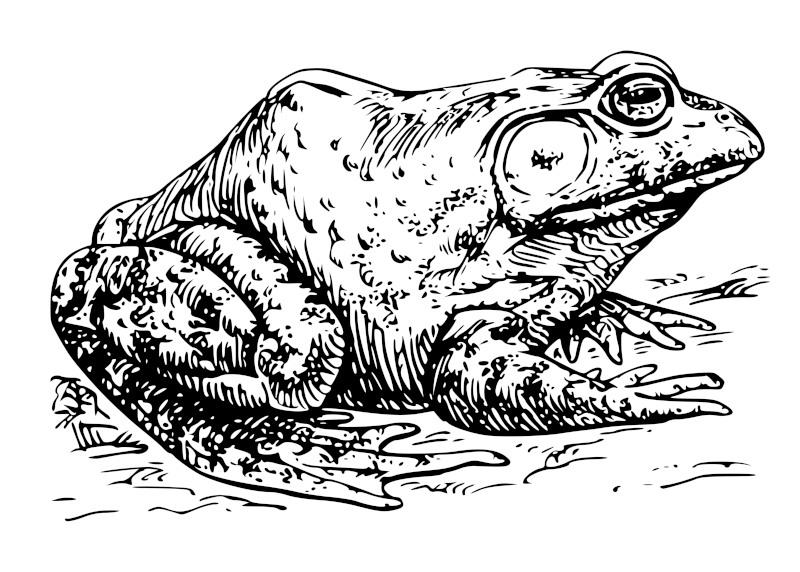 Bullfrog vintage illustration (image courtesy of rawpixel, as copyright-free)
Bullfrog vintage illustration (image courtesy of rawpixel, as copyright-free)
Green Frog Cartoon
This cartoon frog represents the amended way in which frogs have been covered since the early 20th century - notice the human-like features which have helped children to gain a connection to these creatures. We will not often come into contact with frogs, even for those who live in their native countries, but depictions such as this will make them feel much more familiar. Children's stories and cartoons will use froga in this fun manner, and also sometimes present them as established characters with their own unique personalitie. The artistic style therefore focuses on clear lines, filled with a small palette of color to give a clear and concise image.
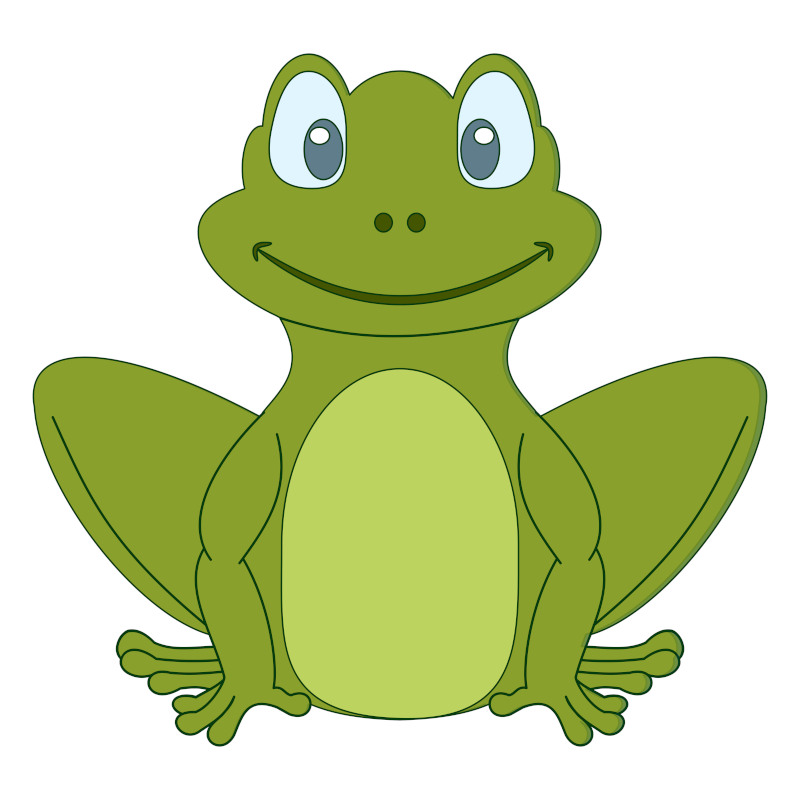 Green Frog Cartoon (image courtesy of rawpixel, as copyright-free)
Green Frog Cartoon (image courtesy of rawpixel, as copyright-free)
Green Frog Anatomy Vintage Painting
Here we find a two tone image covering the anatomy of a frog. The image is almost akin to an x-ray, where details are reduced down to strong contrasts. Those interested in drawing or painting frogs can learn a lot from this artwork, though they might not choose to portray one in quite the same way. One can see each element of its body, and by reducing the body into its key components, it should be easier to cover. Perhaps start by drawing its outline, and then slowly add simple shape to put different parts together.
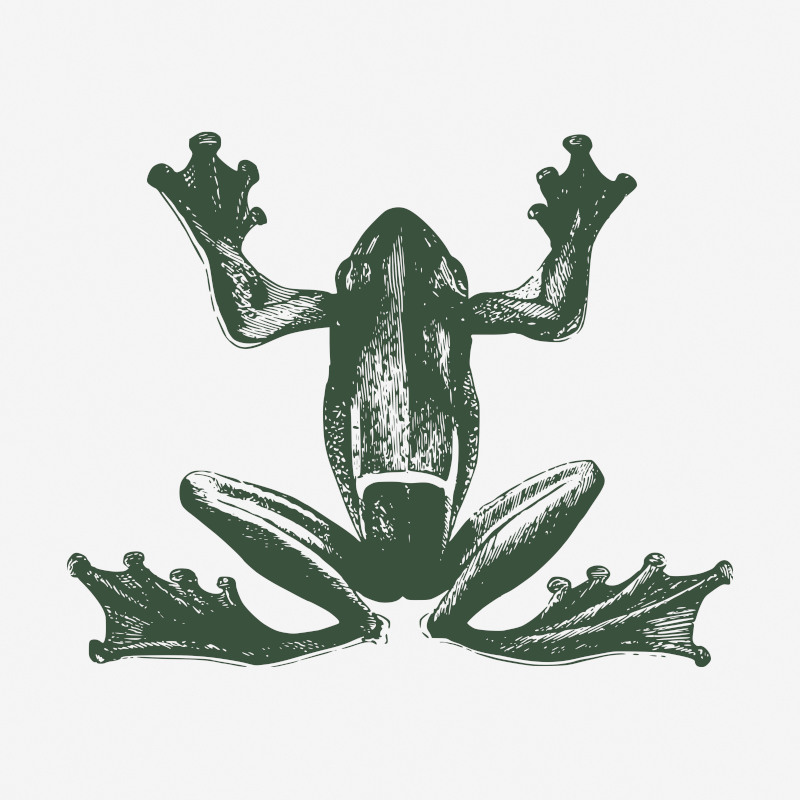 Green Frog Anatomy Vintage Painting (image courtesy of rawpixel, as copyright-free)
Green Frog Anatomy Vintage Painting (image courtesy of rawpixel, as copyright-free)
J. D. Larkin and Co's 19th Century Soap Advertisement Poster.
This truly charming poster advertises an alternative type of cleaning product, and pictures a violinist frog. A moon shape can be seen in the distance, and the relaxed frog is perched on the side of a pond, with flowers and plants all around him, and free flowing water beneath him. The top and bottom elements of the work carry the writing which relates to the product itself, but for an advertisement, the product placement is relatively subtle. In most other cases, the product title would be thrust to the front, taking most of our attention, as seen in some of Alphonse Muchs's posters.
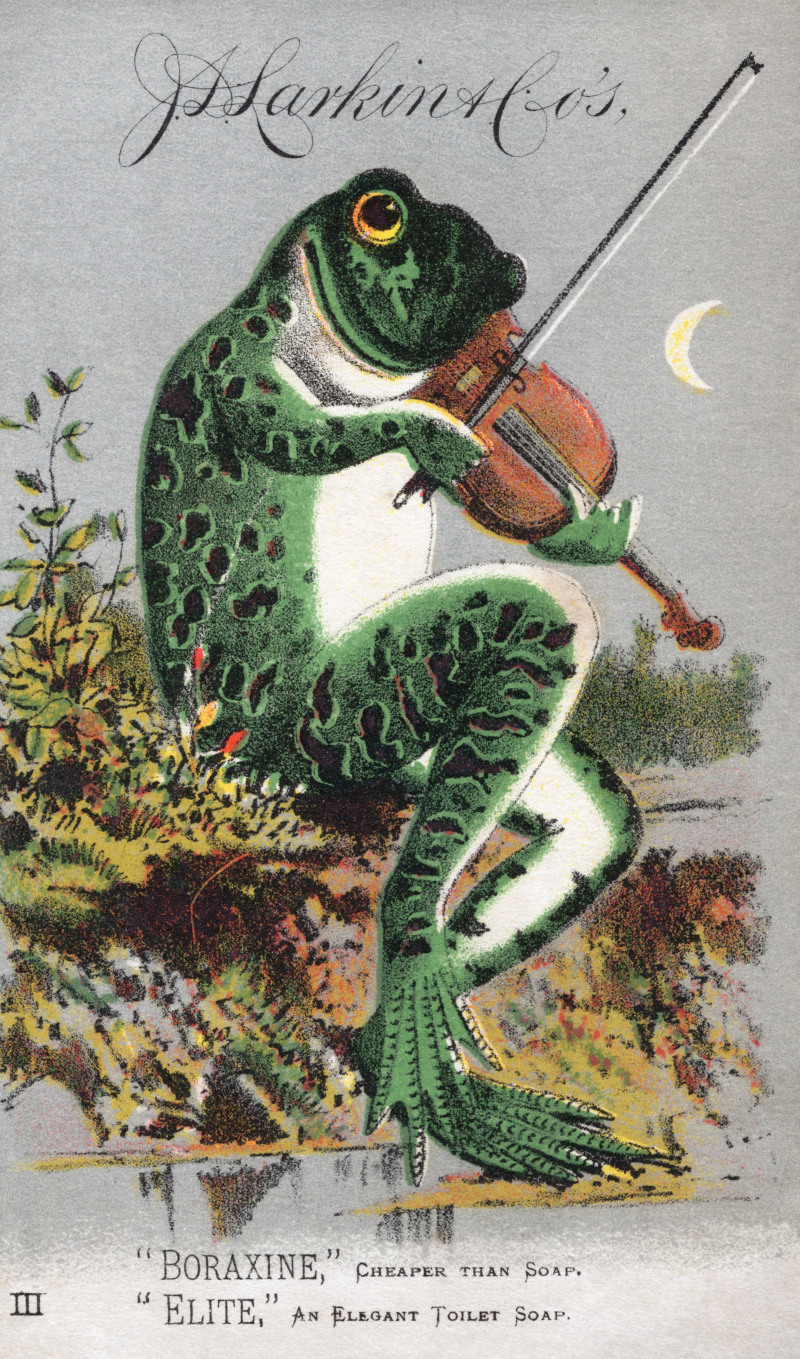 J. D. Larkin and Co's 19th Century Soap Advertisement Poster (image courtesy of rawpixel, as copyright-free)
J. D. Larkin and Co's 19th Century Soap Advertisement Poster (image courtesy of rawpixel, as copyright-free)
Toad png sticker, vintage frog illustration
This delightful toad drawing will help you to understand the difference between a toad and a frog. The level of detail in this drawing is extraordinary, and it can be presented as a sellable artwork, rather than a simple quick study piece. Even the individual claws, and features of the eye can be spotted, when most artists would simplify things to leave out these details. The dabbled patterns include small circles alongside thick, dark stretches of color to provide an accurate depiction of the toad, which presumably was completed by an artist in collaboration with a scientist, or who was simply just very familiar with this creature and able to work without aid.
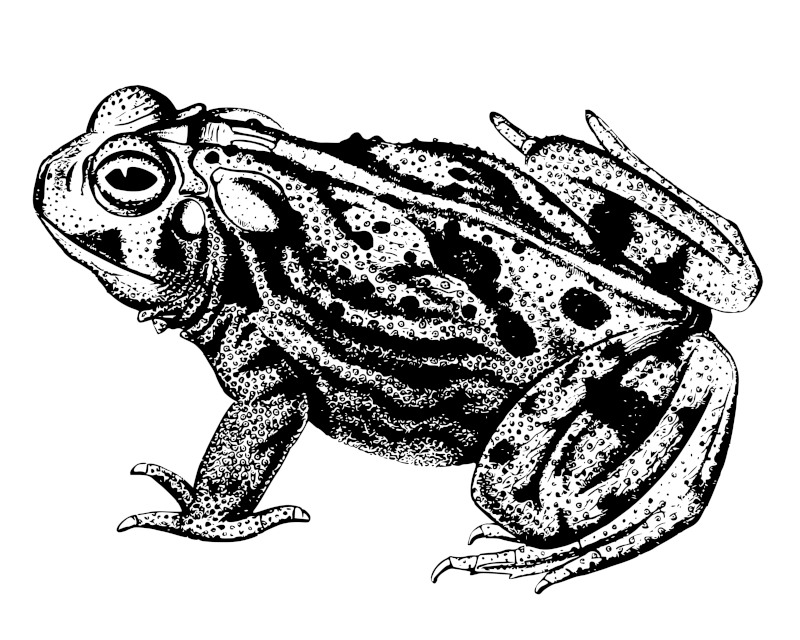 Toad png sticker, vintage frog illustration (image courtesy of rawpixel, as copyright-free)
Toad png sticker, vintage frog illustration (image courtesy of rawpixel, as copyright-free)
Frog Musician Playing Mandolin
Here a frog becomes musician, playing a guitar-like instrument, possibly a mandolin, based on its curved back. The frog looks upwards with the mandolin placed centrally, and this illustration reduces both items to single black lines. Whilst this is a fun depiction, and not intended to be accurate, the artist does include some of the patterning from the frog within this drawing, mainly around its legs. The likes of Artemisia Gentileschi and Frans Hals have covered musicians in enjoyable, charming depictions, and so it was not much of an extension to use frogs for this purpose instead.
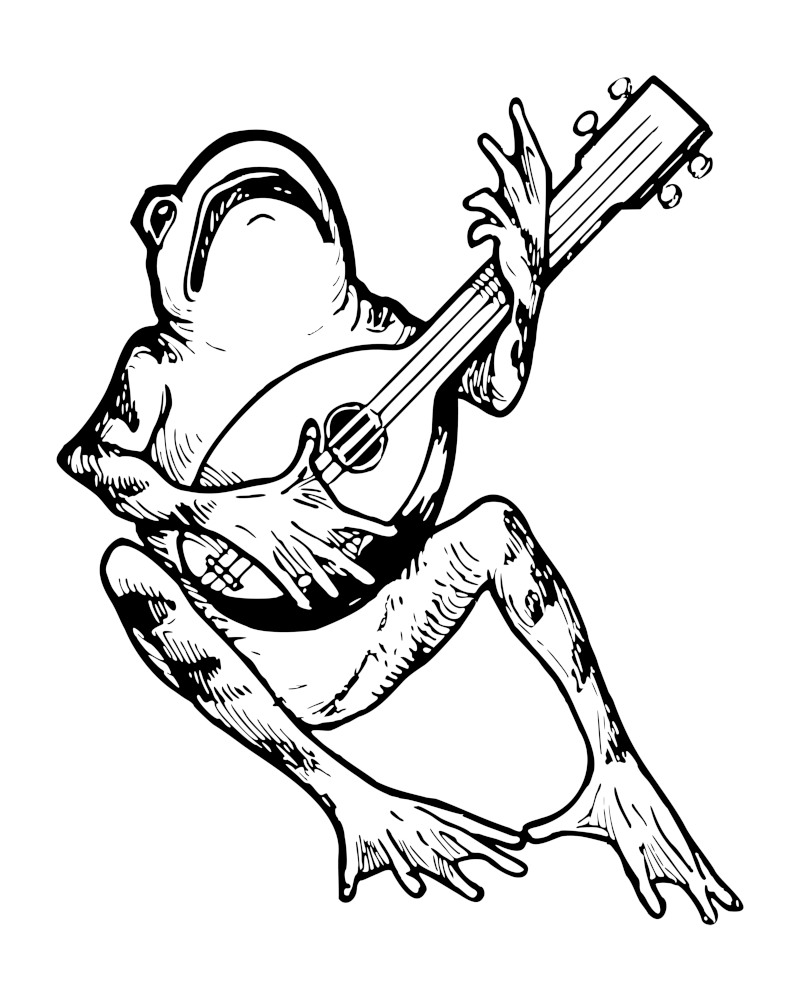 Frog Musician Playing Mandolin (image courtesy of rawpixel, as copyright-free)
Frog Musician Playing Mandolin (image courtesy of rawpixel, as copyright-free)
Ohara Koson's Japanese Frog Sumo (1930) woodblock print
Japanese art has held an interesting relationship with frogs for centuries, and here we find an example of that from 1930. This was designed for reproduction as a woodblock print, which was a highly popular art form within Japan. This medium would also be imported into Europe, and this influenced a number of artists such as Vincent van Gogh and Claude Monet. The piece in front of us here features frogs wrestling, whilst another two watch on.
 woodblock print.jpg) Ohara Koson's Japanese Frog Sumo (1930) woodblock print (image courtesy of rawpixel, as copyright-free)
Ohara Koson's Japanese Frog Sumo (1930) woodblock print (image courtesy of rawpixel, as copyright-free)
Patterned Frog Detailed Drawing
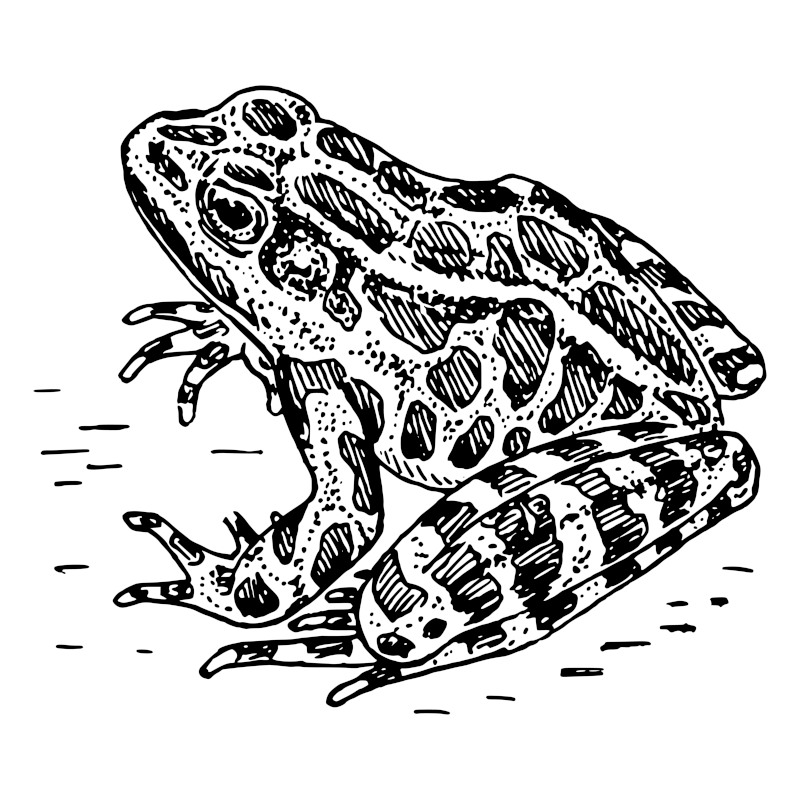 Patterned Frog Detailed Drawing (image courtesy of rawpixel, as copyright-free)
Patterned Frog Detailed Drawing (image courtesy of rawpixel, as copyright-free)
Frog (16th Century) Painting
This painting, possibly using watercolors, dates from the 16th century and illustrates how accurate artists already were in depicting amphibians. The accessible nature to European artists was key to their success, as at this time more exotic animals were often produced in a bizarre manner, because the artists had never seen them in person. The use of light and dark green, along with yellow touches around the eye make this a beautiful artwork. The patterns and texture of the frog are also beautifully done, and this appears to have been intended as a presentable artwork, rather than a study, such is its polished nature.
 Painting.jpg) Frog (16th Century) Painting (image courtesy of rawpixel, as copyright-free)
Frog (16th Century) Painting (image courtesy of rawpixel, as copyright-free)
Exploring the Fascinating World of Frog Drawings and Art
The use of frogs in art has evolved over time in a similar manner to other creatures such as flowers, lions, and other animals. Whilst early, primitive work was something akin to abstract art, later civilizations would start to add a greater accuracy. European painters rarely came into contact with frogs in a way that would suit art, and so would tend to focus on other creatures during the middle ages and since. By the 20th century, however, these fun creatures would start to appear within cartoons and children's stories, often as illustrations alongside the main texts.
This extended into digital art, including computer games such as Frogger which merged video games with animation design. Their image would also appear in other child-related products, such as clothing and bedding, and still today frogs are seen as fun and chirpy creatures who live amongst us, but who were have relatively little contact with on a daily basis.
From Pencil to Canvas: The Evolution of Frog Depictions
The Renaissance era marked a rise in accuracy across the art world, with botanical studies and animal depictions becoming more and more lifelike. Artists spent considerable time observing these different items, whilst also the painting techniques would advance to a point where imagery could almost replicate today's photography. By the time of Impressionism, however, artists were looking to become more expressive and canvases would be seen as an opportunity to express oneself, rather than a challenge to replicate something as closely as possible.
The academic institutions continued to push drawing techniques in pencil and charcoal, but into the 20th century we would start to see many new ideas. Sculptures and Installation art arrived in all manner of different guises, and then we moved on to digital art, where all traditional tools were replaced by digital pens with editing software also bringing new opportunities.
-Cultural Significance: Frogs in Art Across History
Frogs were used as symbols of fertility and rebirth within ancient Egypt, which came from their connection to the flooding of the River Nile, that itself represented fertile soil and from that, food production. This explanation also potentially lies behind the frog-headed goddess Heket. In Sumerian and Babylonian cultures, frogs continued this association with fertility, though Ishtar.
Christians at times have associated frogs in a more negative light, seeing them as unclean due to their natural habitat and its muddy conditions. Frogs infested Egypt in the story of Exodus, and this continued the negative reaction to these creatures. Within ancient Chinese culture, however, frogs are often associated with feelings of luck, prosperity, and transformation and Chan Chu was formed from this. Similar to ancient Egypt, frogs can also be linked to the arrival of rain, and the abundance of food as a result of this.
Colorful Croakers: The Vibrant Palette of Frog-Inspired Artworks
Modern media has normally characterised frogs as green amphibians, but in truth, they can come in all manner of different colors. Artists can therefore choose a species specifically for their artistic purposes, though potentially they can also incorporate their own preferences, even if not accurate, if they choose. This amending of reality has been common since the early 20th century, as found with the likes of Franz Marc, but many others still like to remain faithful to the original tones.
Green tones help to draw the frog into a connection with its natural habitat, allowing the frog to seamlessly blend into its surroundings. Blue frogs can instead relate to the water around them, and also give a sense of tranquility, depending on the hue chosen. Red and orange can give feelings of passion and emotion, whilst also feeling somehat exotic, whilst yellows can serve the opposite purpose to the green, and allow the frog to stand out entirely from its local environment.
Frog Art in Children's Literature: Nurturing Creativity and Curiosity
Frogs can often be depicted as princes within children's literature, as well as explorers. They are normally given strong characters, with a charm and fun personality that children love, where as other creatures are regularly given more negative roles. They are seen as full of life and energy, with expressive faces and also bright tones which ideally suits this type of literature. Many of these traits have then been spread into digital art and films, particularly cartoons.
For many, from an educational standpoint, frogs can be the initial attraction towards becoming interested in amphibians, and the pond habitat more generally. We will often here them as we walk past and this will trigger interest from young children. They are truly unique creatures which offer artists a variety of interesting elements to work with, with some traits now being accepted and passed on across different types of art and literature.
Frog Sculptures and Installations: Blurring the Lines Between Art and Nature
Frog sculptures started to appear in the 20th century, partly due to their popularity amongst children's literature. Child-based attractions would feature them in commercial constructions. More recently, efforts towards conservation have attempted to promote a connection to nature, with the cutest, coolest creatures being used to draw an emotional reaction from us all. Often you will also see sculptures inspired by frogs placed around wildlife centres, as a means to educate children on the types of species living in that environment.
Amphibian Advocacy: Promoting Conservation through Frog Art
Their are many benefits to frog art in relation to conservation. Firstly, it can get children interested in these creatures, and encourage them to learn more about their lives and natural habitat. Once an emotional connection is made, then anyone will be interested in protecting them, if they are deemed under threat. By making frogs feel more relevant in our lives, we will take a greater interest in their existence. Their unique patterns can also add an element of mystery, and are similar to methods of abstract art.
Many will give personality to frogs in order to increase our emotional connection to frogs, which can help in the pursuit of fundraising on their behalf. Many children's stories have already given human characteristics to frogs, and charities have taken a similar approach. In raising funds for their conservation, frog art can have a big impact in protecting their numbers for the long term, and hopefully preserving as many different frog species as possible.
Humor and Whimsy in Frog Art
One will often today see anthropomorphize frogs, which human-like qualities or activities are given to frogs within art. This can be simple, everyday behaviors such as riding a bicycle, or reading a book, and this helps us to feel more connected to the creature. Some illustrated stories have gone further and created specific characters out of frogs, to allow them to have names and genuine identities. For the purposes of comedy and fun, some artists will take the unique elements of frogs and exagerate them, just as caricatures would do with a personal portrait.
In a less flattering manner, humans will sometimes be replaced with frogs in satirical art, providing less then complementary symbolism which derides the original subject. That said, in most cases frogs have been used within art in a positive light and that looks likely to continue, with certain characteristics being indefinitely linked to the creature.
Frogger, the Classic Arcade Game from the 1980s
Frogger remains perhaps the most famous use of frogs within Digital Art. This classic arcade game was first released in the 1980s and has been revamped many times since, as the technology of video game consoles has continued to develop. The simplicity of this game ensured enjoyable gameplay and little to no requirement on learning the game controls or techniques. Even today, many of us will enjoy have another crack at getting the frog across the screen to safety, avoiding all manner of different obstacles along the way.
Frogger chose the theme of frogs because of their popularity with the young, which links back to the creature's use in children's literature, as well as its more recent inclusion as patterns on nightime fashion and bedding. Its funny and cheeky character, as suggested within these interpretations, help us to will the frog on to success, and Frogger remains just another of many examples of the use of frogs within digital design.
Leap into Creativity: Tips for Drawing Realistic Frog Illustrations
There are many stages to drawing and painting frogs effectively, but you do not need to master all of them on day one - instead, simply aim to progress slowly, and move on to each stage when you are already. Initially, observation is key. Knowledge of other creatures may be of little use when working with frogs, as they will have many unique aspects. Studying their anatomy in detail will help you to working in an accurate manner, though you can browse existing frog art for this purpose, if live frogs are not accessible.
Textures and skin patterns are of particular interest to artists, and these need to be covered as part of your process of observation. You might even sketch frog patterns separately, without including the wider context of the frog's body, and this can produce abstract art, with bright colors and bizarre shapes. When ready, start to draw your frog with simple shapes before working in extra detail. Even when painting, it is normally advisable to start with light sketches first, and then working other mediums over the top.



